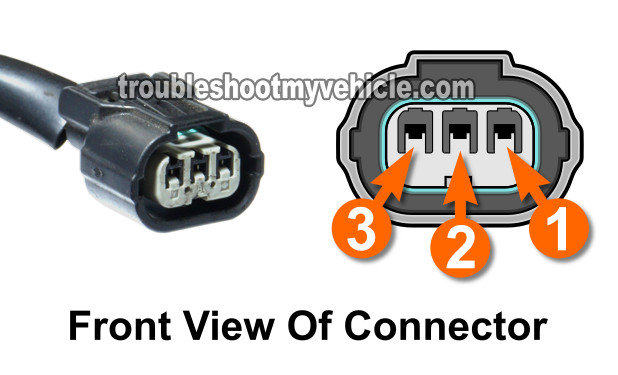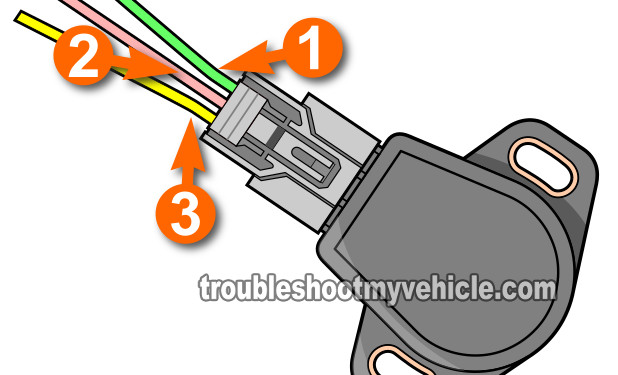
The throttle position sensor (TPS) on your 1.7L equipped Honda Civic can be accurately tested with just a multimeter and without having to remove it from its spot on the throttle body.
In this tutorial, I'll show you where you need to make your multimeter connections to test it and find out if it's bad (or not) and in the process troubleshoot the following diagnostic trouble codes:
- P0122: Throttle Position Sensor Circuit Low Input.
- P0123: Throttle Position Sensor Circuit High Input.
- P1121: Throttle Position Sensor Signal Lower Than Expected.
- P1122: Throttle Position Sensor Signal Higher Than Expected.
Contents of this tutorial:
ES ![]() You can find this tutorial in Spanish here: Cómo Probar El Sensor de la Posición de la Mariposa (2001-2005 Honda 1.7L) (at: autotecnico-online.com).
You can find this tutorial in Spanish here: Cómo Probar El Sensor de la Posición de la Mariposa (2001-2005 Honda 1.7L) (at: autotecnico-online.com).
APPLIES TO: This tutorial applies to the following vehicles:
- 1.7L Honda Civic (DX, EX, LX): 2001, 2002, 2003, 2004, 2005
MAP SENSOR DIAGNOSTIC TESTS:
Basics Of The Throttle Position Sensor (TPS)

The throttle position sensor's job is to measure the angle of the throttle plate as you step on (and step off) the accelerator pedal since the throttle plate is connected to the accelerator pedal via the accelerator cable.
Your Honda Civic's PCM receives this throttle angle info on the middle wire. The other two provide power and Ground (to the TPS).
In the table below, you'll find a short description of what each wire does:
| 2001-2005 1.7L Honda Civic TP Sensor Circuits | ||
|---|---|---|
| Pin | Wire Color | Description |
| 1 | YEL/BLUE | 5 Volt Reference |
| 2 | RED/BLK | Throttle Plate Position Signal |
| 3 | GRN/YEL | Ground |
Where To Buy The Throttle Position Sensor
The aftermarket throttle position sensors that will fit your 1.7L Honda Civic are the: Dorman 977-022 Throttle Position Sensor and the Standard Motor Products T42005 Throttle Position Sensor.
The following links will help you to comparison shop for the Dorman and Stander throttle position sensor on your 1.7L Honda Civic:
Disclosure: As an Amazon Associate, I earn from qualifying purchases. If my tutorials help you, using these links is an easy way to support the site at no extra cost to you. Thank you!
Not sure if the throttle position sensor listed above fits your particular 1.7L Honda Civic? Don't worry, once you get to the site they are going to ask you the specifics of your vehicle to make sure it fits. If it doesn't fit, they'll find you the right one.
TEST 1: Checking The Throttle Position Sensor (TPS) Signal

The key to successfully diagnosing the TPS on your 1.7L Honda Civic is to know that as the throttle plate opens, the TPS produces a higher voltage.
And as the throttle plate closes back to its original position, the TP sensor outputs a decreasing voltage.
So, in this first test step, we're gonna' tap into the TP sensor harness connector's middle RED/BLK wire with a multimeter (set to Volts DC mode) and manually open and close the throttle plate to see if the sensor produces a decreasing/increasing voltage output.
If the TPS is bad, then the voltage output will stay stuck at one value.
IMPORTANT: This is an on car test of the sensor and the throttle position sensor must remain connected to its harness connector.
Here are the test steps:
- 1
Place your multimeter in Volts DC mode and connect the red test lead to the BLK/RED wire of the TP sensor harness connector.
NOTE: The TP sensor connector needs to be connected to the TPS, so you'll need to either back-probe the connector or use a wire piercing probe to get to the signal inside the wire (to see what a wire piercing probe looks like: Wire Piercing Probe Tool). - 2
Ground the black multimeter test lead directly on the battery negative (-) post.
- 3
Manually rotate the throttle.
You'll get the best results by opening and closing the throttle directly on the throttle body instead of stepping on the accelerator pedal. - 4
The multimeter should show an increasing voltage as you (or your helper) open up the throttle.
You'll get the best results by opening and closing the throttle directly on the throttle body instead of stepping on the accelerator pedal. - 5
The multimeter should show a decreasing voltage as you begin to close the throttle.
- 6
Using a screwdriver's handle, gently tap the TP sensor as you open and close the throttle and observer the multimeter.
The purpose (of tapping the TP sensor with the screwdriver's handle) is to see if the TP sensor shows gap's in the voltage signal. Why? Because a good TP sensor will show a continuous increasing or decreasing voltage signal even while getting tapped by the screw-driver's handle.
Let's interpret your test result:
CASE 1: The TP sensor signal's voltage increased and decreased smoothly and without gaps. This is the correct and expected TPS test result. This result tells you that the TPS is working correctly.
This test result also tells you that:
- Circuit #1 is providing power (5 Volts).
- Circuit #3 is providing Ground.
CASE 2: The TP sensor signal's voltage did not increase or decrease. In the majority of the cases this TPS result tells you that the sensor is bad. But not always.
To be sure that the TPS is truly fried, we need to do 2 more tests. These tests involve checking that the sensor is getting both power and Ground. For these tests, go to: TEST 2: Checking Throttle Position Sensor (TPS) Power And Ground.
CASE 3: The TP sensor signal's voltage showed gaps in its voltage output as you tapped the sensor with the screwdriver. If the gaps in the multimeter's voltage readings only showed up when you were tapping on the TPS (with the screwdriver's handle) then this test result tells you that the TPS is bad and needs to be replaced.
TEST 2: Making Sure The TPS Is Getting Power

If you've reached this point in your TPS diagnostic, then the sensor has not produced a voltage signal that increases or decreases as you manually open and close the throttle plate.
The next step in confirming that the TPS is bad is to make sure it's getting power —which comes in the form of 5 Volts DC.
The wire that delivers this 5-Volt signal to the TP sensor is the yellow with blue stripe (YEL/BLU) wire of the sensor's 3-wire connector. This wire connects to female terminal 1 of the connector.
This voltage is available with the key in the RUN or START position, but for our test, we'll check it with the key in the RUN position and the engine OFF.
Here's what you need to do to confirm this voltage:
- 1
Disconnect the TP sensor from its 3-wire connector.
- 2
Set your multimeter to Volts DC mode.
- 3
Connect the black multimeter test lead to the battery's negative (-) post.
- 4
Turn the key to the RUN position, but don't crank or start the engine.
- 5
Gently probe female terminal 1 with the red multimeter test lead.
NOTE: Double-check that terminal 1 actually connects to the YEL/BLU wire of the connector. - 6
Your multimeter should register between 4.5 and 5 Volts DC.
CASE 1: The YEL/BLU wire is delivering 5 Volts. This is the correct and expected test result.
Now that you've confirmed the TP sensor is getting the voltage it needs to function, your next step is to make sure it's getting Ground from your Civic's PCM. For this test, go to: TEST 3: Making Sure The TPS Is Getting Ground.
CASE 2: The YEL/BLU wire isn't delivering 5 Volts. Double-check your test connections and repeat the test.
If you still don't see 4.5 to 5 Volts at terminal 1, we can conclude that the TP sensor itself isn't the cause of the engine performance issue or the TPS code lighting up the check engine light.
Although it's beyond the scope of this tutorial, you'll need to determine why this voltage is missing at terminal 1 and repair the issue. Once the TP sensor is receiving its 5-Volt supply, it'll function again and the TPS trouble code will clear.
TEST 3: Making Sure The TPS Is Getting Ground

So far, the previous two multimeter tests you've performed have confirmed the following:
- The TPS voltage signal does not increase or decrease as you open and close the throttle plate.
- The sensor is receiving 5 Volts from the PCM.
For our third and final TP sensor diagnostic test, we're going to make sure that female terminal 3 of the TPS 3-wire connector is supplying Ground.
This is a PCM-supplied Ground, which means it's only available with the key in the RUN or START position. For this test, we'll check it with the key in the RUN position but with the engine OFF.
The wire that delivers this Ground to terminal 3 is the green with yellow stripe (GRN/YEL) wire of the connector.
NOTE: Since this Ground is provided internally by your Honda Civic's PCM, it's critical that you do not accidentally or intentionally connect this circuit to battery voltage (12 Volts). Doing so will deep fry the PCM. The multimeter voltage test outlined below is a safe way to check for the presence of this Ground in the circuit.
OK, let's begin:
- 1
Disconnect the TP sensor from its 3-wire connector.
- 2
Set your multimeter to Volts DC mode.
- 3
Connect the red multimeter test lead to the battery's positive (+) post.
- 4
Turn the key to the RUN position, but don't crank or start the engine.
- 5
Gently probe female terminal 3 with the black multimeter test lead.
NOTE: Double-check that terminal 3 actually connects to the GRN/YEL wire of the connector. - 6
Your multimeter should register between 10 to 12 Volts DC.
Alright, let's find out what it all means:
CASE 1: The GRN/YEL wire is delivering Ground. This is exactly the result we wanted to see. It confirms that the sensor is getting the Ground it needs to function.
You can conclude that the throttle position sensor is bad and needs to be replaced only if your tests have confirmed the following:
- The TPS signal voltage output does not increase or decrease with throttle plate movement (TEST 1).
- The TP sensor is receiving 5 Volts from the PCM (TEST 2).
- In this test section, you've confirmed that the sensor is getting Ground from the PCM.
Whenever you're ready to replace the TP sensor, I recommend the Dorman TP sensor. It's a reliable part from a well-known aftermarket brand. I've used Dorman products for as long as I can remember in my automotive repair career, and I never hesitate to recommend them:
- Dorman 977-022 Throttle Position Sensor (Amazon affiliate link).
CASE 2: The GRN/YEL wire IS NOT delivering Ground. Make sure you're testing the correct terminal on the connector and repeat the test.
If terminal 3 still isn't supplying Ground to the sensor, then we can rule out the TP sensor itself as bad —because without this Ground, it simply can't function.
Although it's beyond the scope of this tutorial, your next step is to find out why this PCM-supplied Ground is missing at terminal 3 and repair the issue. Once your Civic's TP sensor starts receiving Ground again, it'll function, and the TPS trouble code will clear.
More 1.7L Honda Civic Diagnostic Tutorials
You can find a complete list of diagnostics tutorials for your 1.7L Honda Civic in this index:
Here's a small sample of the tutorials you'll find:
- How To Test The MAP Sensor (2001-2005 1.7L Honda Civic).
- How To Test For A Blown Head Gasket (2001-2005 1.7L Honda Civic).
- How To Test The Crank Sensor (2001-2005 1.7L Honda Civic).
- How To Test Trouble Code P0141 (2001-2005 1.7L Honda Civic).

If this info saved the day, buy me a beer!




